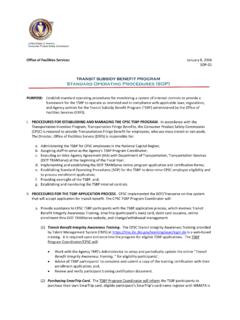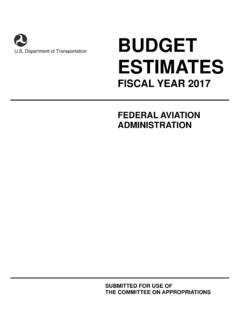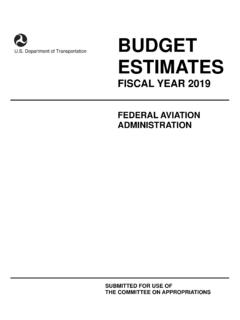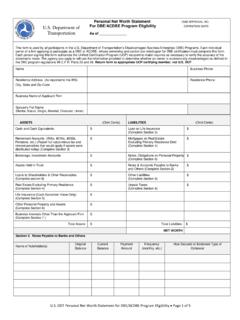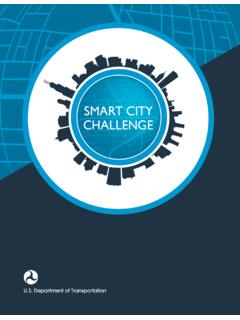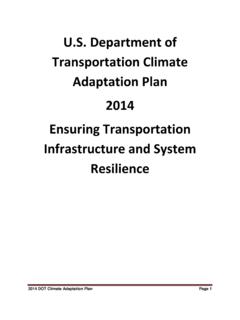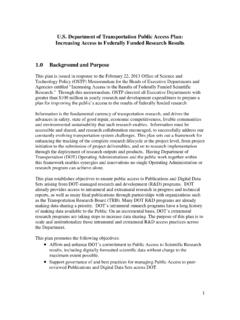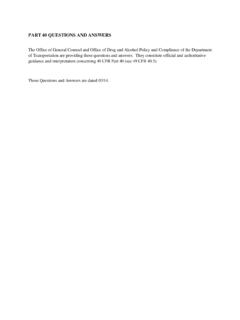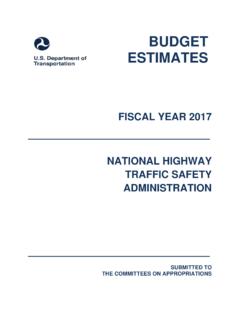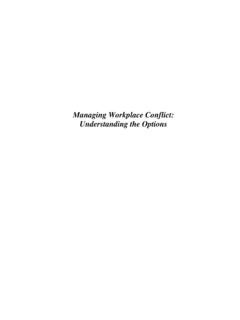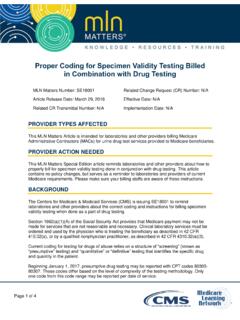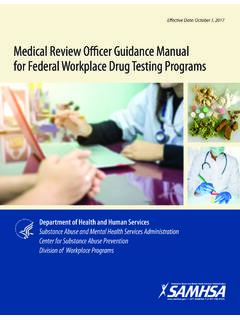Transcription of Urine Specimen Collection Guidelines January 2018
1 Urine Specimen Collection Guidelines United States Department of Transportation Office of Drug and Alcohol Policy and Compliance Revised January 2018 DOT Urine Specimen Collection Guidelines 2 Office of Drug and Alcohol Policy and Compliance Revised January 2018 DOT Urine Specimen Collection Guidelines for the Department of Transportation Workplace Drug testing Programs (49 CFR Part 40) Revised January 2018 [previous editions become obsolete]. These Guidelines apply only to employers and individuals who come under the regulatory authority of the Department of Transportation (DOT) and those individuals who conduct Urine Specimen collections under DOT regulations. The term employee is used throughout this document and has the same meaning as donor as used on the Federal Drug testing Custody and Control Form (CCF). These Guidelines are a complete revision of the DOT Urine Specimen Collection Procedures Guidelines , 49 CFR Part 40, for Transportation Workplace Drug testing Programs.
2 It contains minimal graphics and formatting to ease transmission and downloading of the document from the Internet. All information appearing in these Guidelines is in the public domain and may be used or reproduced without permission from DOT or others. Citation of the source is appreciated. This document may be updated or modified based on additional interpretations or other procedural changes. Collectors and service agents should check the ODAPC web site periodically to ensure that they have the latest version: . DOT Urine Specimen Collection Guidelines 3 Office of Drug and Alcohol Policy and Compliance Revised January 2018 INTRODUCTION The Department of Transportation's (DOT) Operating Administrations Federal Aviation Administration, Federal Motor Carrier Safety Administration, Federal Railroad Administration, Federal Transit Administration, Pipeline and Hazardous Materials Safety Administration and United States Coast Guard (now with the Dept.)
3 Of Homeland Security) have issued regulations requiring anti-drug programs in the aviation, highway, railroad, transit, pipeline, and maritime industries. The DOT Agencies' rules require that employers conduct drug testing according to provisions of 49 CFR Part 40, "Procedures for Transportation Workplace Drug testing Programs." The procedures for Collection of Urine under these rules are very specific and must be followed whenever a DOT-required Urine Specimen Collection is performed. (The only exception is the Federal Railroad Administration's Post-Accident Toxicological testing Program in which a railroad representative will provide the collector specific instructions and a testing kit.) These procedures, including use of the Federal Drug testing Custody and Control Form (CCF), apply only to DOT-required testing . While employers may use our Collection and testing procedures for testing under employer or state authority, they must not use a Federal CCF, nor can they imply that company tests are conducted using DOT authority.
4 The collector has a major role in the success of the DOT s drug testing program. The collector is the one individual in the testing process with whom all employees have direct, face-to-face contact. Without the collector assuring the integrity of the Specimen and Collection process, the test itself may lose validity . Without the collector's sensitivity to an employee's privacy, the entire testing program may be subject to criticism. It is imperative that collectors fully understand and follow these procedures. These Guidelines , together with 49 CFR Part 40 and the DOT operating administrations' rules, will provide collectors with the information needed in the performance of their Collection duties. The information in this document addresses and provides guidance concerning normal Collection procedures and some of the more common problems or situations encountered. However, information contained in this publication should not be used to interpret or be viewed as adding to or modifying the legal requirements of the actual rule.
5 DOT Urine Specimen Collection Guidelines 4 Office of Drug and Alcohol Policy and Compliance Revised January 2018 TABLE OF CONTENTS SECTION 1. COLLECTOR .. 5 SECTION 2. Collection SITE .. 6 SECTION 3. Collection SUPPLIES .. 7 SECTION 4. FEDERAL DRUG testing CUSTODY AND CONTROL FORM .. 8 SECTION 5. INFORMATION EMPLOYERS PROVIDE TO COLLECTORS .. 10 SECTION 6. EMPLOYEE IDENTIFICATION .. 10 SECTION 7. Collection PROCEDURES .. 11 SECTION 8. SHY BLADDER PROCEDURES .. 20 SECTION 9. DIRECTLY OBSERVED COLLECTIONS .. 22 SECTION 10. MONITORED COLLECTIONS .. 24 SECTION 11. PROBLEM COLLECTIONS .. 25 SECTION 12. CORRECTING Collection 28 APPENDIX A TRAINING REQUIREMENTS FOR COLLECTORS .. 30 APPENDIX B Collection SITE SECURITY AND INTEGRITY .. 32 APPENDIX C DOT STANDARDS FOR Urine Collection KITS .. 33 APPENDIX D DIRECT OBSERVATION PROCEDURES .. 35 APPENDIX E QUESTIONS AND ANSWERS .. 36 APPENDIX F OPERATING ADMINISTRATIONS RULES (SUMMARY).
6 36 DOT Urine Specimen Collection Guidelines 5 Office of Drug and Alcohol Policy and Compliance Revised January 2018 SECTION 1. COLLECTOR Part 40 defines a collector as a trained person who instructs and assists employees at a Collection site, who receives and makes an initial inspection of the Urine Specimen provided by those employees, and who initiates and completes the Federal Drug testing Custody and Control Form (CCF). Note: DOT does not require or provide collector certification. Collectors need to have documentation reflecting that they have met appropriate training requirements at Appendix A. Any individual, who has received training specified in 49 CFR Part 40 ( ) for conducting the required Collection procedure, may serve as a collector except in the following situations: 1. The immediate supervisor of a particular employee may not act as the collector when that employee is tested, unless no other collector is available and the supervisor is permitted to do so under a DOT operating administration s drug and alcohol regulation.
7 (The immediate supervisor may act as a monitor or observer (same gender) if there is no one else available at the Collection site to conduct a monitored or observed Collection .); 2. An employee who is in a safety-sensitive position and subject to the DOT drug testing rules should not be a collector, an observer, or a monitor for co-workers who are in the same testing pool or who work together with that employee on a daily basis. This is to preclude any potential appearance of collusion or impropriety; 3. An individual working for an HHS-certified drug testing laboratory ( , as a technician or accessioner) may not act as a collector if that individual can link the employee with the Specimen drug test result or laboratory report; and, 4. The employee may not be the collector of his or her own Urine Specimen . Note: To avoid a potential conflict of interest, a collector should not be someone that is related to the employee ( , spouse, ex-spouse, relative) or a close personal friend ( , fianc e).
8 A collector should have appropriate identification, which includes the collector s name and the name of the Collection Company or clinic. The collector is required to provide his or her identification if requested by the employee. There is no requirement for the collector to have a picture or to provide his or her driver's license with an address or telephone number. Also, the collector is not required to provide any certification or other documentation to the employee documenting the collector's training. However, the collector must provide this documentation on request to DOT agency representatives and to employers and service agents (SA) or Consortium/Third Party Administrators (C/TPAs) who are using or negotiating to use that collector s services. The employer must provide the collector with the name and telephone number of the appropriate Designated Employee Representative (DER) and C/TPA, where applicable, to contact about any problems or issues that may arise during the Collection process.
9 DOT Urine Specimen Collection Guidelines 6 Office of Drug and Alcohol Policy and Compliance Revised January 2018 SECTION 2. Collection SITE A Collection site is a place (permanent or temporary) selected by the employer where employees present themselves for the purpose of providing a Urine Specimen for a DOT-required drug test. Generally, there are two types of Collection facilities: 1. A single-toilet restroom, with a full-length privacy door, or 2. A multi-stall restroom, with partial-length doors. A Collection site must have: 1. A restroom or stall with a toilet for the employee to have privacy while providing the Urine Specimen . Whenever available, a single toilet restroom, with a full-length privacy door, is preferred. All types of restrooms including a mobile facility ( , a vehicle with an enclosed toilet) are acceptable. 2. A source of water for washing hands that, if practical, is external to the restroom where urination occurs.
10 If the only source of water available is inside the restroom, the employee may wash his or her hands, and then the collector must secure the water source ( , use tamper-evident tape, cut off the water supply) before the Collection takes place. If water is not available at the Collection site, the collector may provide moist towelettes outside the restroom. 3. A suitable clean surface for the collector to use as a work area and for completing the required paper work. A second type of facility for urination, which can be used as a Collection site, is a multi-stall restroom. Such a site must provide substantial visual privacy ( , a toilet stall with a partial- length door) and meet all other requirements listed above (2 and 3). Additionally, if a multi-stall restroom is used, the collector must either: 1. Secure all sources of water and other substances that could be used for adulteration and substitution ( , water faucets, soap dispensers) and place bluing agent in all toilets or secure the toilets to prevent access; or 2.
